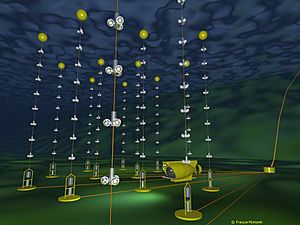Antares Telescope facts for kids
ANTARES is a special underwater telescope. It is a neutrino detector located 2.5 kilometers (about 1.5 miles) deep in the Mediterranean Sea. It is off the coast of Toulon, France. This telescope helps scientists find tiny particles called neutrinos that come from space.
ANTARES looks for neutrinos coming from the Southern Hemisphere of the Earth. It works together with another neutrino telescope called IceCube at the South Pole. IceCube looks at neutrinos from both the Northern and Southern Hemispheres. The name ANTARES stands for Astronomy with a Neutrino Telescope and Abyss environmental RESearch project. The name is also shared with a bright star called Antares. This project is officially recognized by CERN, a big science organization. ANTARES finished collecting data in February 2022, after working for 16 years.
Contents
How ANTARES Works
The ANTARES telescope is made of twelve long, vertical strings. Each string has 75 special light sensors called photomultiplier tubes. Each string is about 350 meters (1,150 feet) long. They are anchored to the seafloor about 2.5 kilometers (1.5 miles) deep. The strings are placed about 70 meters (230 feet) apart from each other.
When certain neutrinos, called muon neutrinos, travel through the Earth, they sometimes hit water particles in the Mediterranean Sea. When this happens, they create a fast-moving particle called a muon. As the muon travels through the water, it gives off a special blue light called Cherenkov radiation. The photomultiplier tubes in ANTARES detect this light. This helps scientists figure out where the neutrinos came from. The telescope is designed to tell the difference between muons coming from space (which are not what they are looking for) and muons created by neutrinos that have traveled through the Earth.
ANTARES uses water to detect this light, unlike the South Pole telescopes AMANDA and IceCube, which use ice. Light travels better in water than in ice. This means ANTARES can pinpoint the direction of neutrinos more accurately. However, seawater has more natural light sources, like potassium-40 (a radioactive element in salt) and glowing sea creatures (bioluminescence). This means ANTARES needs special ways to block out this extra light.
Building ANTARES
The construction of ANTARES was finished on May 30, 2008. This was two years after the first string of sensors was put into the sea. Testing for the project began in 2000. Some equipment, like a seismometer (which measures earthquakes), was put in place in 2005.
The first string of photomultiplier tubes was lowered into the sea in February 2006. By September 2006, the second string was successfully connected. Strings 3, 4, and 5 were put in place at the end of 2006 and connected in January 2007. This made ANTARES the largest neutrino telescope in the Northern Hemisphere at that time. Strings 6 through 10 were put in place between March and November 2007. They were connected in December 2007 and January 2008. Since May 2008, the detector has been working with all 12 strings.
The French oceanographic institute, IFREMER, helped with putting the detector parts into the sea and connecting them. They used a special underwater robot called the ROV Victor. Sometimes, they also used the submarine Nautile.
What ANTARES Hopes to Discover
The ANTARES project works with the IceCube Neutrino Observatory in Antarctica. Both telescopes use similar ways to detect neutrinos. ANTARES is especially good at finding neutrinos with lower energies, particularly those coming from the southern sky. This area includes many sources of neutrinos within our own galaxy.
ANTARES looks for neutrinos with energies between 10 GeV and 100 TeV. Over many years, it could create a map showing where these cosmic neutrinos come from in the Southern Hemisphere. Scientists are very interested in finding specific points in space that produce neutrinos. They hope to match these findings with observations from other telescopes, like gamma-ray sources seen by the HESS telescope in Namibia.
Besides studying neutrinos from space, ANTARES also helps with big questions in particle physics. For example, it searches for dark matter. Dark matter is a mysterious substance that scientists believe makes up a large part of the universe. ANTARES looks for signs of dark matter particles called neutralinos. If neutralinos were to collide and disappear (called annihilation) in the Sun or at the center of our galaxy, they might produce neutrinos that ANTARES could detect. Finding these signals would also support a theory called supersymmetry. ANTARES might also look for other rare particles, like nuclearites or magnetic monopoles.
Discoveries and Findings
The first neutrinos were detected by ANTARES in February 2007.
After collecting data for six years, scientists used ANTARES to search for specific sources of neutrinos near the center of our galaxy. They did not find any clear point sources there. ANTARES also helped measure how atmospheric neutrinos (neutrinos created in Earth's atmosphere) change as they travel.
Other Instruments on ANTARES
Besides its main job of detecting cosmic neutrinos, the ANTARES experiment also has other tools. These tools study the deep sea environment. They include sensors that measure how salty the water is (salinity) and how much oxygen is in it. There are also tools to measure sea currents, how light travels through the water, and the speed of sound.
A camera system was also installed to automatically track glowing sea creatures (bioluminescence). The information from these instruments is important for making sure the neutrino detector works correctly. This data is also shared with ocean science groups who work with the ANTARES project.
ANTARES has a system to keep its floating detector lines in the right place using sound. It also has a separate system called AMADEUS. This system uses special microphones to listen for neutrinos deep in the sea. Some of these acoustic sensors are on a special "instrumentation line," and others are on the 12th detector line.
See also
 In Spanish: ANTARES (telescopio) para niños
In Spanish: ANTARES (telescopio) para niños


